Introduction
- Complex infrastructure suffers from management throughout the project lifecycle.
- Complex infrastructure projects include undertaking life cycle at various stages:
- obligations;
- administrative abilities;
- risk bearing limits;
- clashing interests.
The construction division in Saudi Arabia is the biggest and quickest developing business sector in the Gulf Area.
Saudi Arabia ⇒ development blast ⇒ more than 23,500 progressing ⇒ US$ 869 billion.
To introduce the project, it is essential to mention that the current Complex Infrastructure in Saudi Arabia has witnessed an array of issues with management processes such as obligations, clashing interests, and more. As Saudi Arabia is experiencing a development boost but has limited capabilities regarding project development, there is a need in proposing a viable framework that would address this issue.
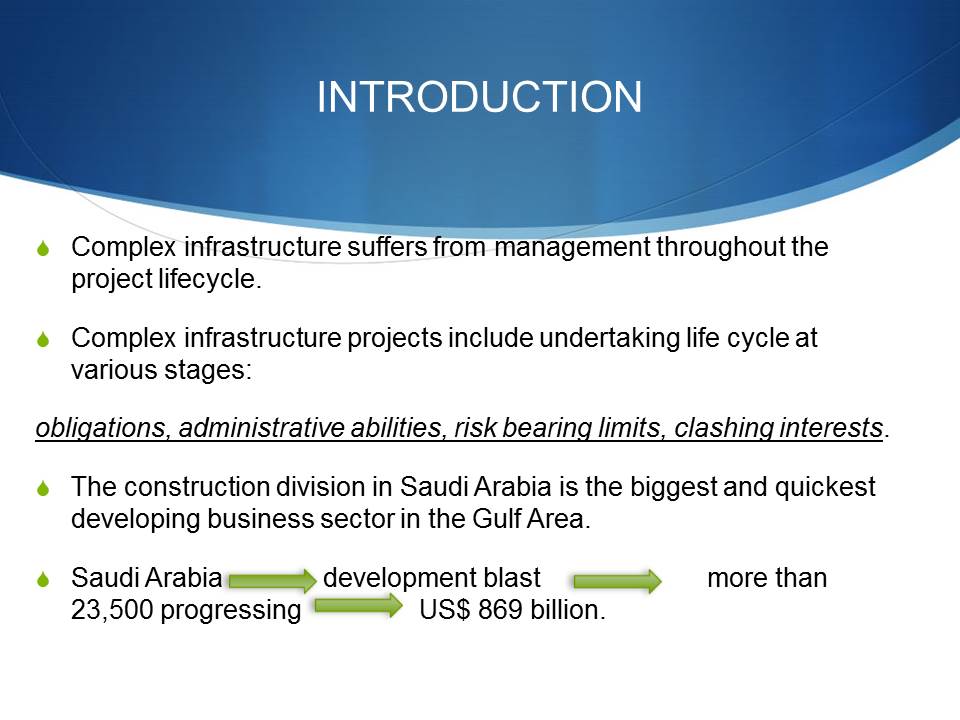
Proposal Background
- Project management procedures: utilization of learning abilities, devices, and systems to extend exercises to meet the task necessities (Elawi, Algahtany, & Kashiwagi, 2016).
- “Benefit management”: recognizing, investigating and arranging, conveying, transiting and managing benefits (Elawi et al., 2016).
- Receiving benefit management will help in crossing any barrier between procedure definition and project management.
- Issue to resolve with benefit management: misalignment between project administration and operations administration (Al-Sultan, 1987).
- Consequently, project execution contains general operations and setting up new activities.
When discussing the background for the proposal, it is important to mention the term of benefit management as a tool for best practices targeted at the management of benefits. The process can eliminate misalignments between operations and projects administration for setting up new activities in construction projects.
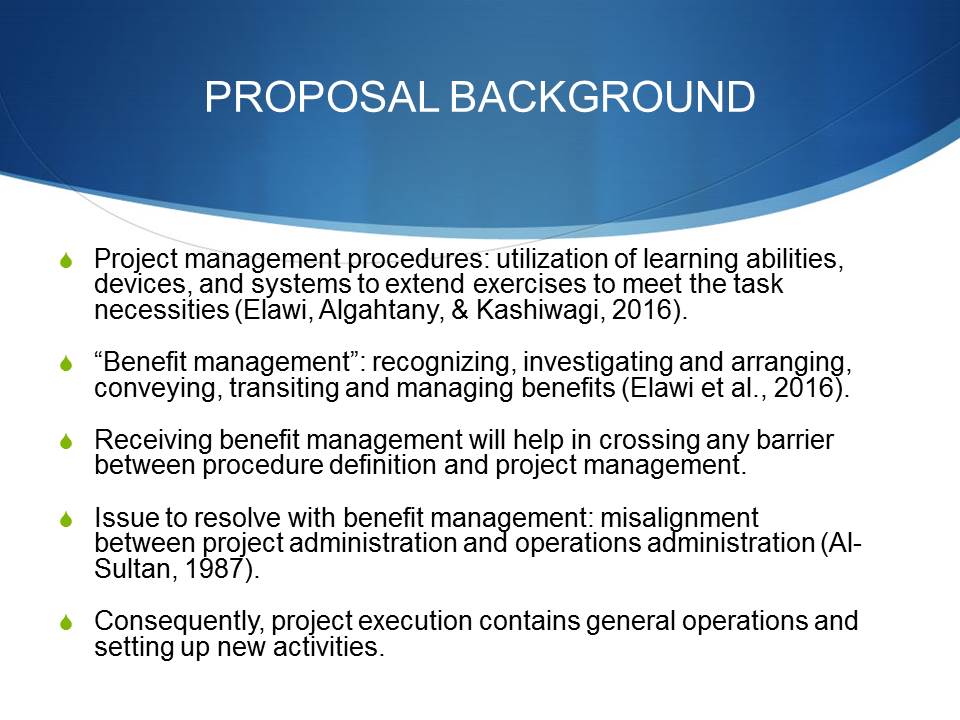
Mandate of the National Project Management Organization in Saudi Arabia
SNPMO’s restructuring projects lead to challenges.
Proposal will enhance quality management. Benefits are the following:
- Enable task administration application through:
- gathering abilities;
- information;
- instruments;
- strategies.
- Suggest regulations and arrangements for project management.
- Monitor and regulate national tasks and project execution.
- Encourage development change through adjusting.
- Create project management center to catch, make, bind, share data.
As the National Project Management Organization in Saudi Arabia has witnessed several restructuring projects, the institution is currently struggling with great challenges. The proposed framework for processes enhancement includes enabling task administration, project management through arrangements and regulations, project execution through monitoring, developmental change, and creation of project management centers. Importantly, task administration can be achieved through the gathering of relevant abilities, information, strategies, and instruments.
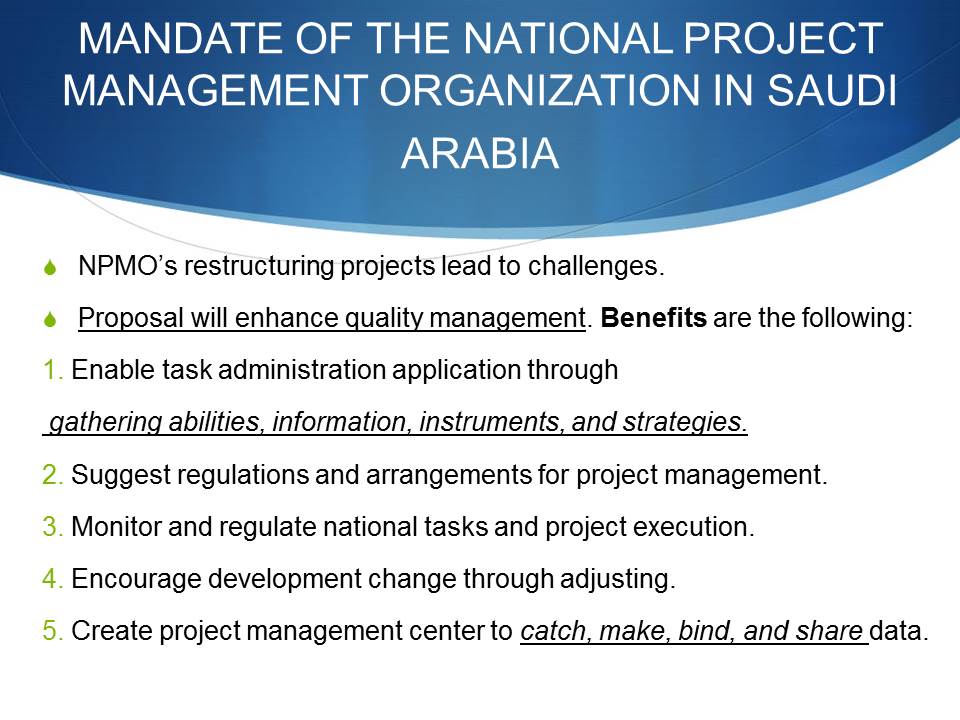
Problem Statement
- Postponements in conveying infrastructure ⇒ issues to investors, the government, and the economy.
- Postponements in project delivery change ⇒ costs of materials.
- Delay causes are divided into nine categories.
- Investigations showed that construction execution in Saudi Arabia is poor (Alzara, Kashiwagi, Kashiwagi, & Al-Tassan, 2016).
- Expanding venture execution in Saudi Arabia ⇒ reexamining the acquirement conveyance framework.
As any proposal comes with a problem statement, it is essential to identify several issues that hinder the effectiveness of construction projects in Saudi Arabia. Such issues involve postponements, investor issues, high costs, and inefficient frameworks. Delay causes are divided into nine categories: financing, materials, legally binding connections, changes, government relations, labor, planning and control, hardware, and environment. The key problem statement for the proposal is that the execution of construction in Saudi Arabia is poor.

Proposal Framework & Objectives
- BV PIPS can manage essential delay causes in Saudi Arabia.
- The foundation of choosing project contractors does not mirror the genuine cost of activities.
- The NPMO must acknowledge and actualize the best practice execution framework (BV PIPS) in Saudi Arabia.
⇓
- Recognize delay causes in national projects.
- Show how BV PIPS can manage imperative delay components.
- Educate project owners on choosing contractors.
- Utilize BV PIPS model to distinguish how to expand construction industry execution in Saudi Arabia.
Within the proposed framework, it is essential to mention the role of best practice execution as applied to construction projects in Saudi Arabia. Project objectives include recognizing construction delay causes, showing ways of managing delays, educating on choosing contractors, and expanding the construction industry in Saudi Arabia.
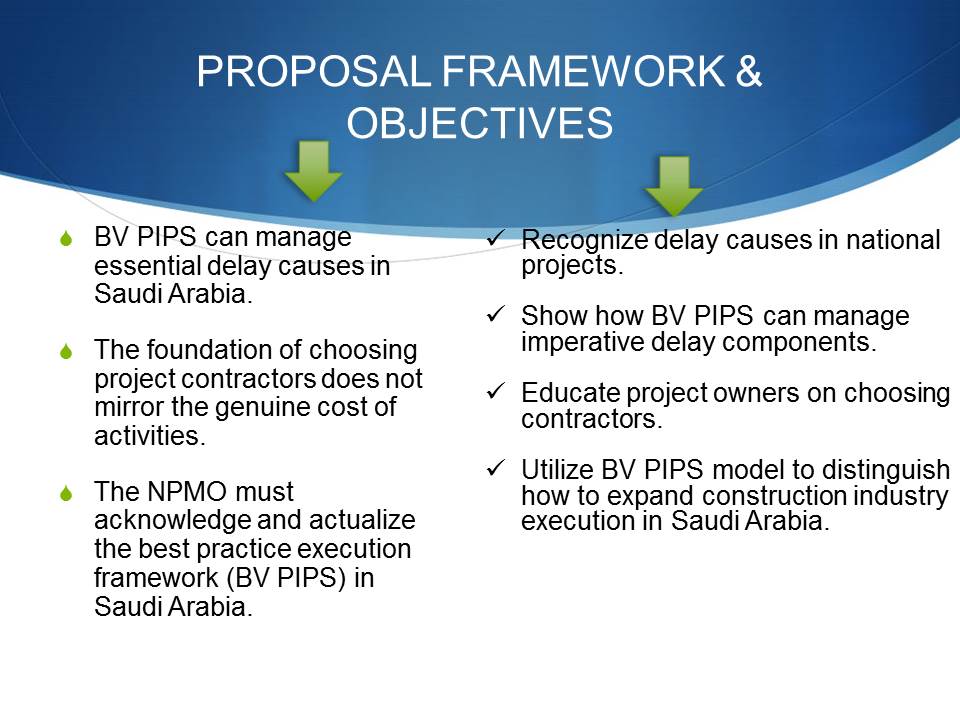
Current Data
The table below shows the extent of the pressure on the construction industry in Saudi Arabia through listing the largest construction projects, their cost, completion date, and locations.
Despite challenges in the current construction sphere of Saudi Arabia, the country is at the peak of its development and is planning to expand through mega construction projects. “Selected mega construction projects in Saudi Arabia” table shows that the country expects several large construction projects to be completed both in the nearest future and as far as in 2035. Because of such a load on the construction industry, it is essential to propose an effective framework that would improve the processes involved in the construction as well as propose best practices for the overall improvement of the construction industry in Saudi Arabia.
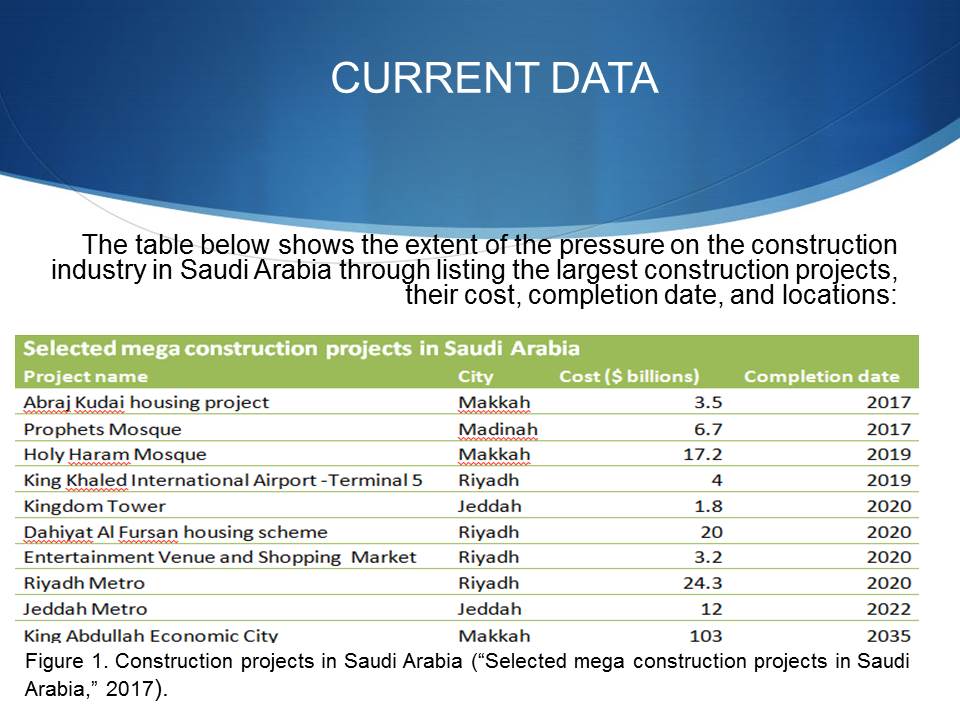
Literature Review
- Al Turkey (2011): 75% of Saudi national projects face delays.
- Assaf and Al-Hejji(2006): contractors additionally acquire overhead expenses.
- Al-Kharashi and Skitmore(2009): site contractors suffer from multiple challenges.
- Mahamid(2013): proprietors cannot anticipate to what extent tasks will take.
- Mahamid (2013): expansion time is one of the proprietors related deferred factors.
- Mahamid (2013): surveys show that proprietor endorsed expansion time on 87% of ventures.
Starting from this slide, a literature review on the topic will be presented.
It has been found that 75% of Saudi national projects faced delays (Al Turkey, 2011).
It is important to mention that overhead expenses limit contractors from getting other tasks.
Moreover, site contractors suffer from: time of venture, expanding overhead cost, and thwarting contractual workers from other business opportunities.
Proprietor Related Causes
- Mahamid(2013): proprietors put off capital installments ⇒ a defer factor.
- SAl Turkey (2011): construction orders changed by the proprietor upset contractual workers’ calendars ⇒ project delays.
- SAl Turkey (2011): low-tender criteria is viewed as a purpose behind the pervasiveness of task delays in Saudi Arabia.
Contractor-Related Factors
- Al Turkey (2011): project failures ⇒ ability deficiencies, poor estimation practices, and poor leadership.
Mahamid (2013) and Al-turkey (2011) provided relevant evidence for the study. Researchers suggested that many of national projects were undermined by the causes associated with proprietors and contractors. Among defer factors were delays in capital installments, changes in construction orders, and low-tender criteria. As to contractor-related factors, project failures were caused by ability deficiencies, lack of effective leadership, and poor practices of estimating deadlines or costs.
Advisor-Related and Other-Related Causes
- Project delay elements can be connected to an advisor.
- A project advisor a mediator between the contractor and proprietor.
- An advisor influences project delays
- Postponement of material delivery ⇒ project length.
- Correspondence and coordination improve the odds of accomplishing complex activities.
- Corruption causes delay projects and cost overruns.
- Government fraud causes delays for personal gains.
Another category of issues that undermine the effectiveness of construction projects in Saudi Arabia was related to issues caused by advisors and other factors. Among disruptions caused by advisors, configuration archives, evaluating, and approving site designs and records have been identified. It is also essential to underline the negative role that corruption and government fraud play in undermining projects’ integrity.
Low-Bid Technique and Cost Overruns
Wong, Holt, and Cooper (2000): in the UK, the Finance Boards utilized performance bids form to evaluate contractors because of a low-offer delivery framework.
Plebankiewicz (2009): national projects awarded to qualified contractors would expand the achievement rates of undertakings.
Holt, Olomolaiye, and Harris (1995): project quality and time are not seen as being as imperative as low-bid offers
Elawi et al. (2016): in Saudi Arabia, the choice of qualified contractors is influenced by numerous hindrances:
- budget plan;
- trouble of basic leadership;
- delivery time;
- inexperience;
- absence of competent specialists;
- hierarchical worry of accomplishing specific design.
Numerous hindrances limit the decision-making process with regards to choosing appropriate contractors. For example, the trouble of basic leadership due to the lack of professional experience, absence of competent specialists, and hierarchical worry of accomplishing a specific design, delivery time, and budget plan (Elawi et al., 2016).
Abu Nemeh (2012): Saudi project sector: contractor-determination technique does not meet customers’ desired cost overruns, contractual worker disappointment, expanding changes, and low quality.
Olaniran (2015): the likelihood that the real expenses of tasks are hidden increases if a cost-based determination is considered.
Abu Nemeh(2012): a contractor who has the minimal offer as a rule presents a gauge that is lower than the task’s budget.
Olaniran(2015): reasons for low venture execution.
As seen from the evidence presented in the slide, cost overruns and low-bid techniques also undermine the integrity of construction projects in Saudi Arabia. Olaniran (2015) provided reasons for low venture execution, such as:
- bidders decrease their overall revenues.
- low level of task control used by numerous site engineers.
- inadequacy of selected contractors.
GCC Review
For an investor/proprietor, time defers causes loss of income.
For a contractor, project delays cause cost overruns because of:
- remuneration of wages for delayed time
- overabundance of charges for plant and hardware
- material and space use
- loss or damage of project materials
- inflation.
Olaniran (2015): large portion of the reasons for delays occurs in the development stage because unexpected dangers are constantly included.
In this slide, characteristics of the GCC region with regards to construction project issues are provided. It is essential to mention that construction projects in the GCC suffer from income fluctuations, continuous delays, as well as unexpected dangers that stop the process of construction altogether. Economic factors such as inflation in the region also play a significant role.
- Olaniran(2015): understandable deferrals are compensable, e.g., outline changes or late arrival of designs.
- Olaniran (2015): contractors collect extra cost from the proprietor as circuitous expenses for the additional overhead costs.
- Mahamid(2013): different examinations have been performed in GCC to decide the reasons for delays on infrastructure projects.
- Hirsch and Catchim (2012): dangers are considered as non-specific to construction ventures.
- Al Turkey (2011): researchers observed that project performance must be assessed based on cost, plan, quality, and investor’s fulfillment.
In this continuation of the GCC review, it was identified that delays in infrastructure projects could range from compensable deferrals to unclear qualities of project performance. Overhead costs are also a problem since they lead to additional expenses and delays in payments, which subsequently decrease the efficiency of construction projects.

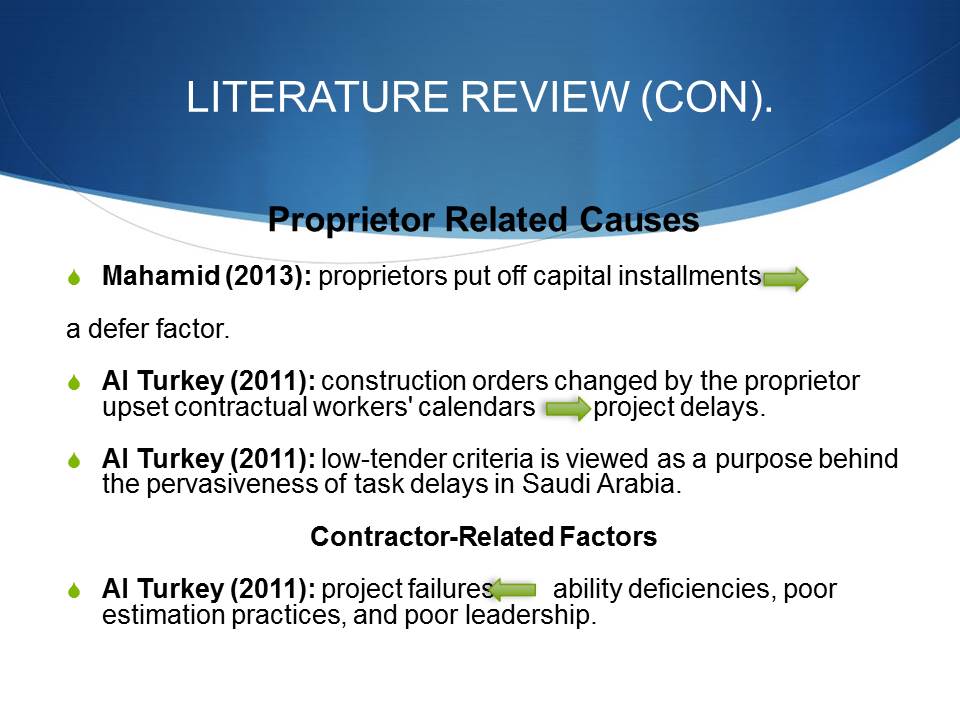
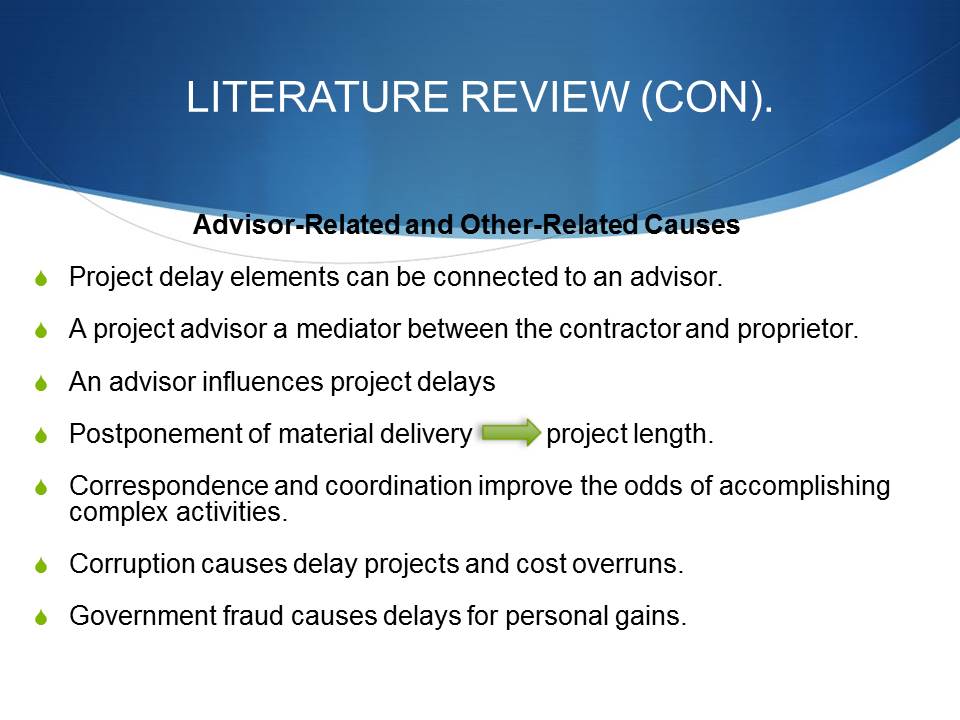
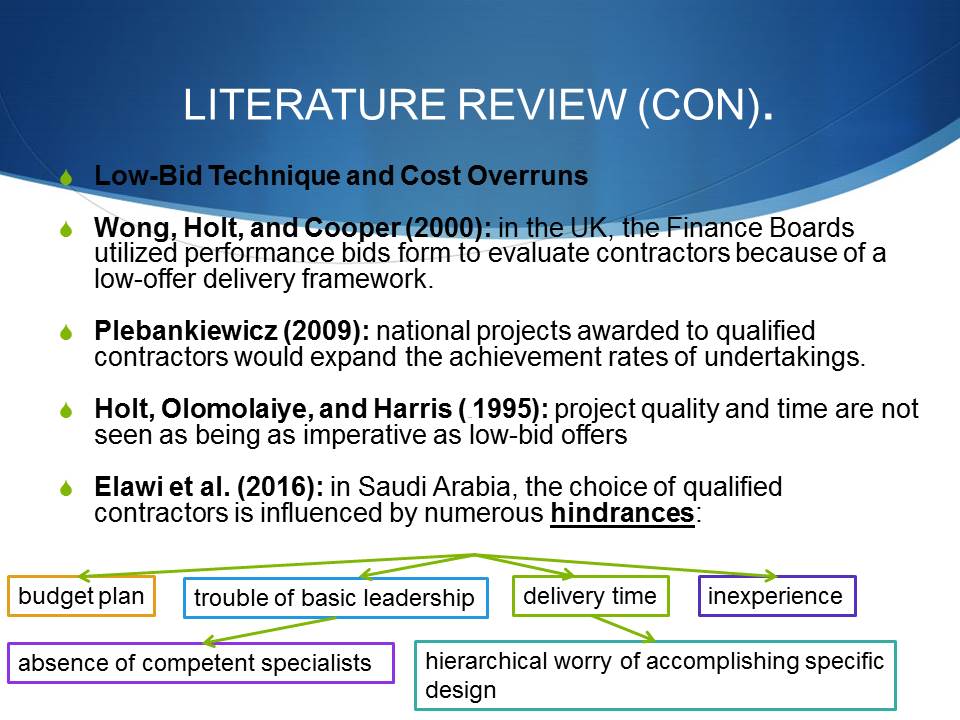

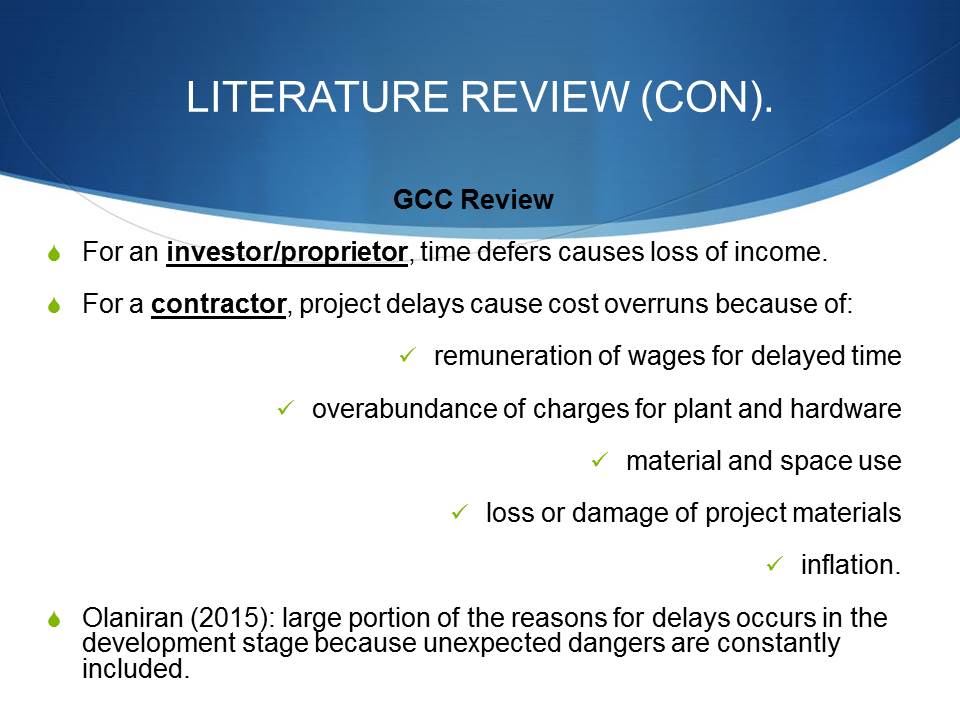
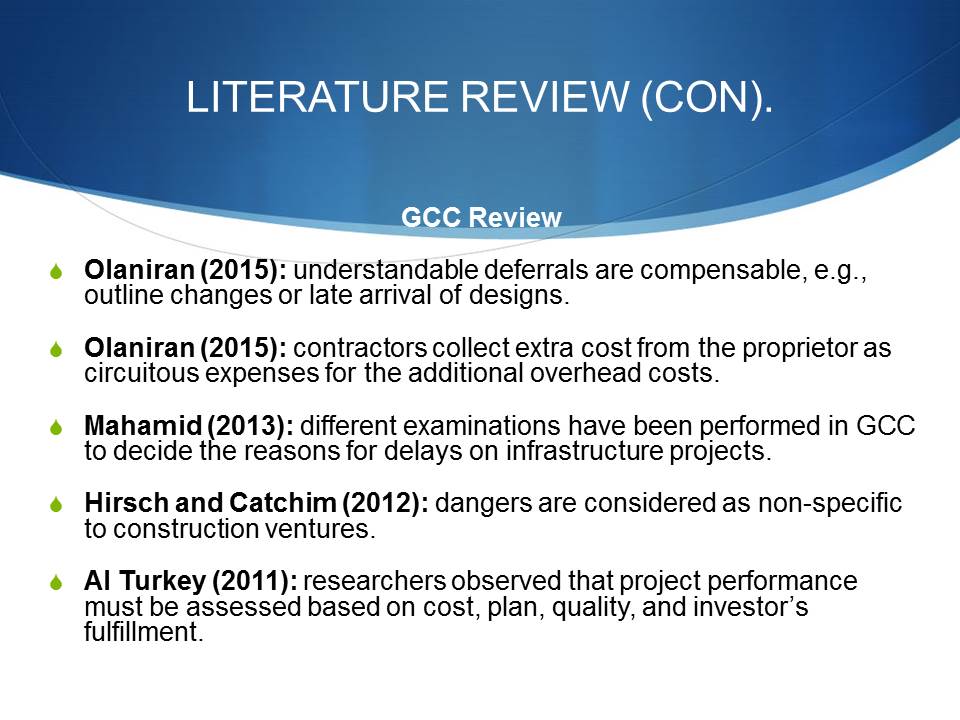
Methodology for the Proposal
- The model would enhance project completion and reduce cost overruns.
- This model has demonstrated a more elevated amount of project management than the low-offer framework.
- A contextual investigation was conducted using SA as a sample specimen.
- We collected information concerning project delays on contracts that utilized the low-offer framework.
- Project contractors and engineers were instructed to ascertain delay causes from a proprietor’s point of view.
Based on the analysis, we proposed a model for best practices for the National Project Management Office in Saudi Arabia: Best Value Performance Information Procurement System. It is proposed to implement this system as a method for enhancing the completion of projects and reducing overall costs. Importantly, evidence for the model’s proposal was collected on the basis of actual projects that took place in Saudi Arabia.
A model of BV PIPS that could be executed in Saudi Arabia was proposed for:
- Organizing reasons for project delays.
- Organizing reasons for cost overruns.
- Analyzing the current model (low-bid procurement factor).
- Concurrence with the BV PIPS standards.
- Concurrence with the proposed best practice.
Data was collected from 800 confidential project contractors and the results were subjected to factual examination.
The examination of evidence for offering a reliable framework for a proposal recognized techniques for improving project management procedures and various approaches for enhancing the current circumstance in the industry. In summary, the proposed framework (with a specific goal to have positive results in Saudi infrastructure projects) is associated with numerous components of construction projects that could make them more efficient and reliable.
Reasons for Delay Factors
- After organizing project delay causes through surveys, they were contrasted with deferred factors around the country.
- The correlation demonstrated the imperative factors facilitated cost overruns and project delays.
- The investigation at that point clarified how BV PIPS could manage critical delay components to enhance project execution in Saudi Arabia.
Reasons for Cost Overruns
- After organizing reasons for budget overruns through a survey, information of cost overruns was contrasted with BV PIPS execution.
Within the examination of issues that limit the efficiency of construction projects in Saudi Arabia, delay factors present the most challenges. BV PIPS is expected to be an effective framework for managing important delays in project execution. Also, cost overruns are also challenging for construction processes and BV PIPS can address them.
Basis for NPMO Inclusion in Project Management Practices
- Postponements in conveying infrastructure projects ⇒ issues to investors, the government, and the economy.
- Task proprietor inclusion, contractor capabilities, design outline, and project framework are vital elements for project delay in Saudi Arabia.
- Proprietors indicated that reasons for the delay are identified with corruption and poor performance.
- Site engineers ⇒ serious purposes of postponement ⇒ proprietors.
- In the absence of corruption, contractor determination has been done based on the costs offered by bidders.
When it comes to providing reasoning for the inclusion of NPMO in project management practices, it is important to mention that postponements cause problems to such stakeholders as the environment, economy, and investors (and subsequently the industry overall). While proprietors pointed to corruption and poor performance as reasons for delays, site engineers pointed at proprietors’ ineffectiveness.
- Irregularities in the phrasing of issued by various supervisory units: proprietor, advisors and contractual workers ⇒ postponements.
- To diminish this effect, it’s advised to distribute ordinary contracts + related revisions and understandings.
- This channel must be supervised by the management office.
- Effective channels may lessen conflicting interpretation.
- Relieve issues and misinterpretations of the proprietors, contractors, and experts.
It is proposed to implement the BV PIPS process for streamlining the processes associated with the improvement of irregularities that exist in the phrasing of documentation. Because of such irregularities, proprietors, advisors, and contractors can all experience delays in productivity and thus impact the construction process overall. For dealing with this problem, the framework advises to give out ordinary contracts supervised by the management office to lessen conflicting interpretation.
- Once an undertaking is established by parliament and a financial plan is approved, the administration calls for tenders.
- Advisors and contractors examine the courses of events and write proposals.
- This wasteful technique causes over 18% of the deferrals under the law, control, and other general imperfections.
- Once the profiles are proposed, the government creates and keeps emergency courses of action for various tasks given the hazard profiles.
- Political unsteadiness directly affects the hazard profile of development ventures at different levels.
With regards to governmental control of construction projects, there are several issues that can be managed with the help of the proposed framework of BV PIPS in Saudi Arabia. Such issues include wasteful proposals, law imperfections, tenders, emergency courses for action, and political unsteadiness.
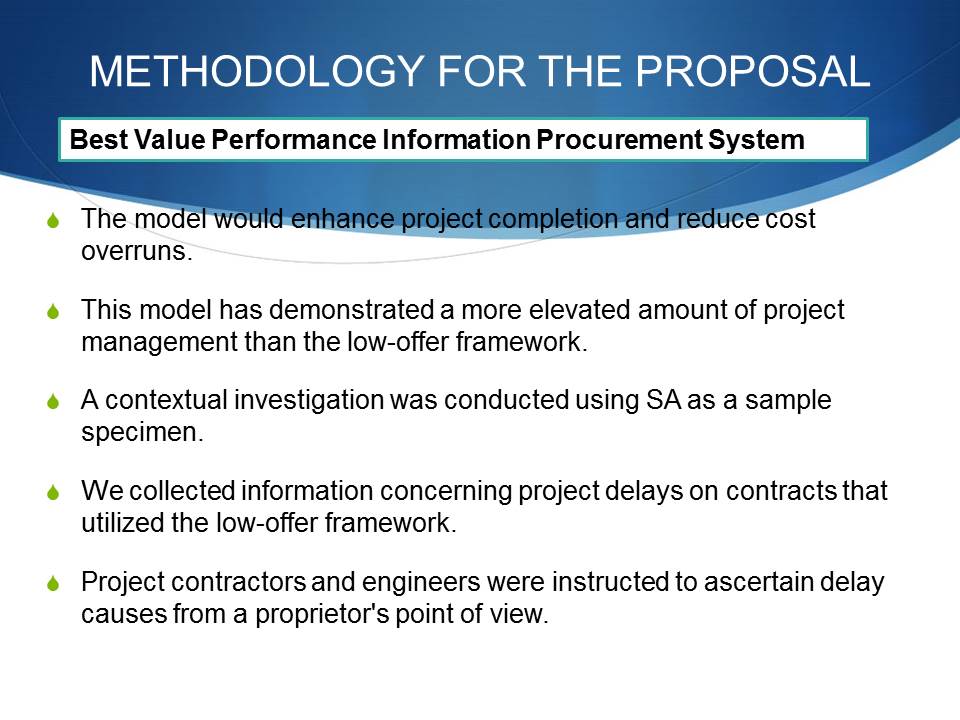
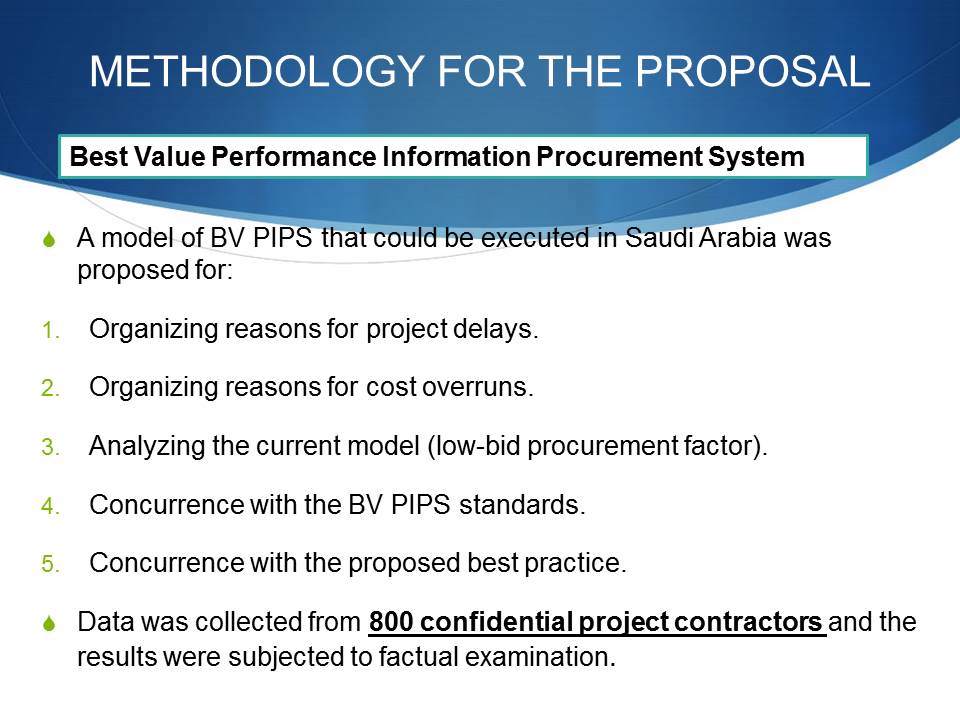
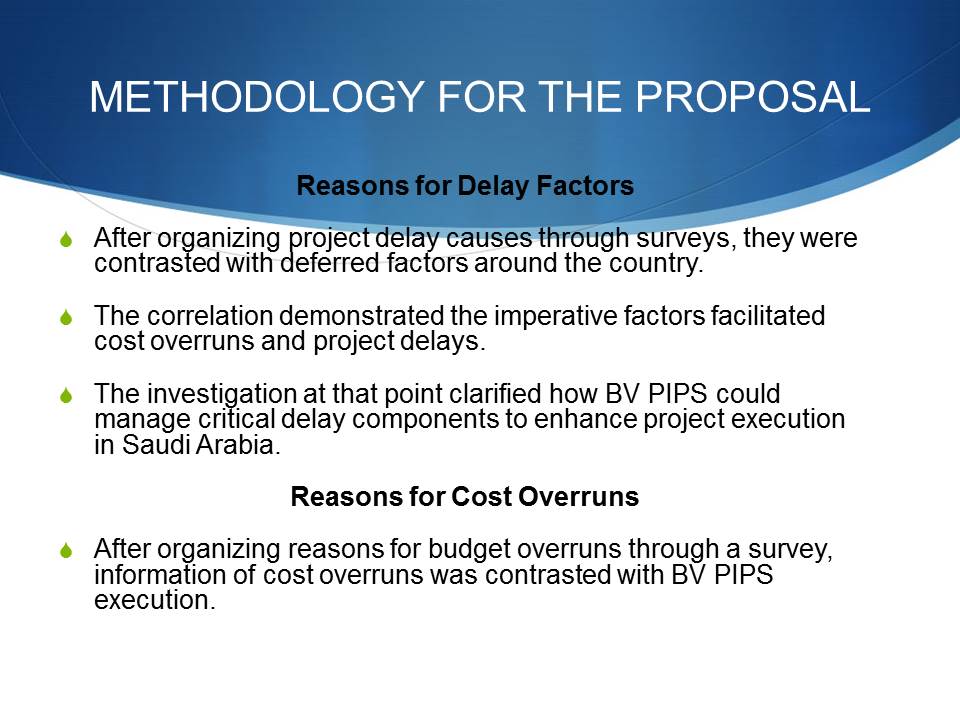
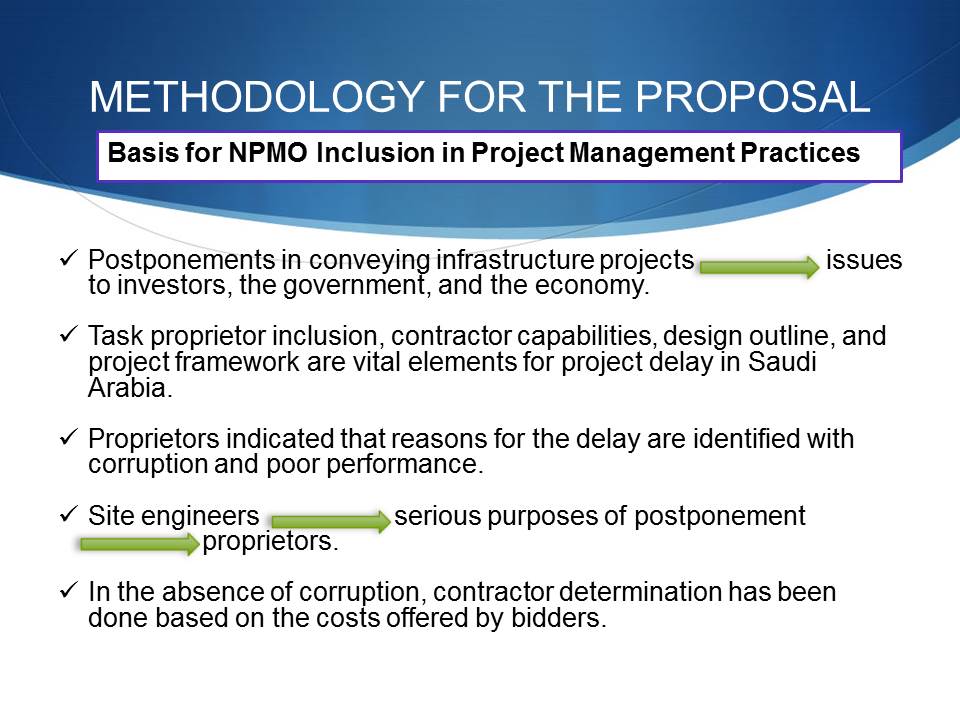
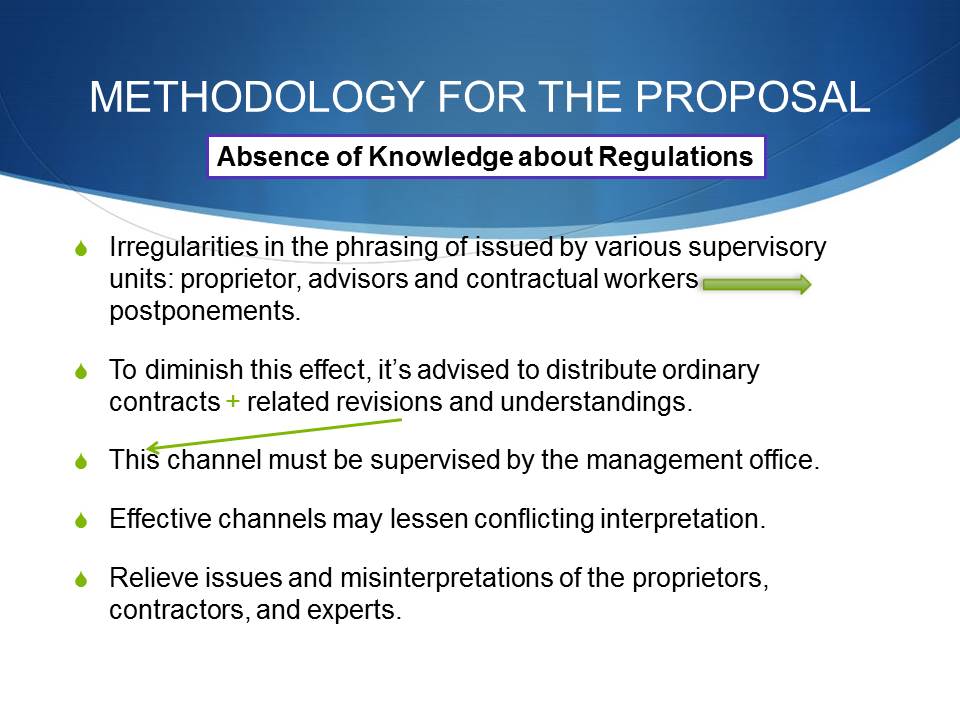
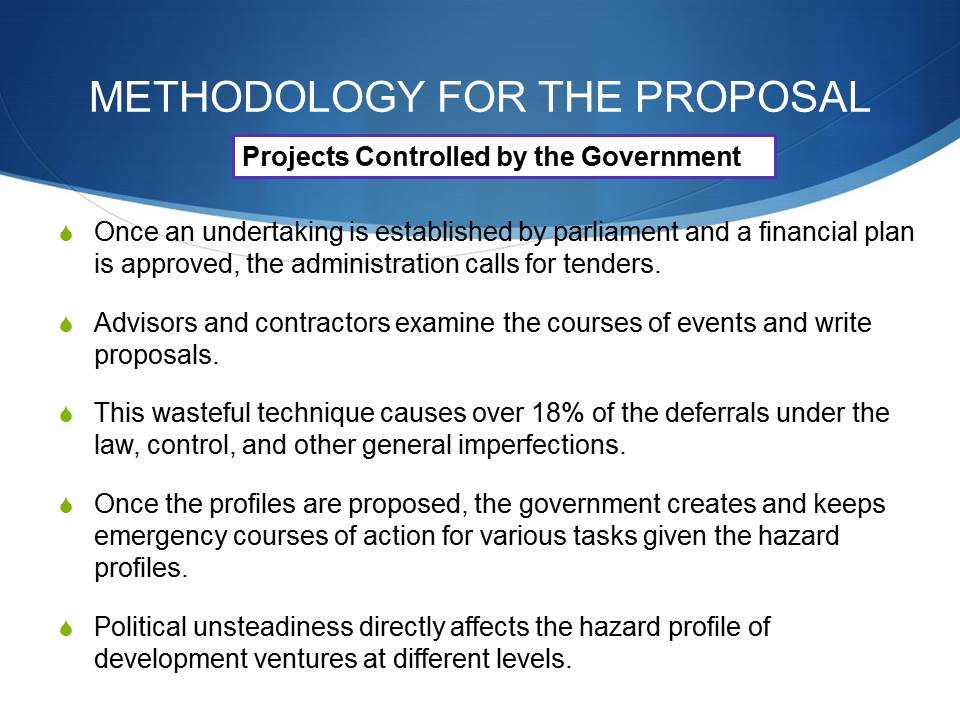
Proposing Best Practices for the National Project Management Office in Saudi Arabia
- We propose the Best Value and Performance Information Procurement System for National Project Management Office in Saudi Arabia.
- BV PIPS concentrates on finding and utilizing qualified contractors to expand the execution of undertakings.
- Execution measurements of PIPS ventures were completed on the spending plan, time, and quality.
- PIPS have been tried with more than 1,900 undertakings with $8.3 billion task value.
- These task measurements demonstrate a 98% rate of accomplishment in 6 nations and 31 states (Kashiwagi, 2011).
When it comes to proposing best practices for the National Project Management Office in Saudi Arabia, it was suggested to implement the Best Value and Performance Information Procurement System, which focuses on using skilled contractors that can efficiently plan execution time, costs, and quality of construction projects.
The BV Pips Process:
- Pre-capability stage;
- Interpretation stage;
- Selection stage;
- Execution stage;
- Pre-capability stage:
- This discretionary stage instructs contractors about BV PIPS.
- It also shows contractors how to submit proposals to demonstrate project execution.
The process associated with Best Value and Performance Information Procurement System includes three stages, such as the pre-capability stage, the selection state, the interpretation stage, and the execution stage. First, it is important to discuss the first stage: the pre-capability (or discretionary) stage. At this stage, contractors are being informed about basic processes involved in the BV PIPS for ensuring the appropriate integration of the framework. Importantly, the pre-capability stage of the framework is important for showing contractors how to submit their proposals on demonstrating the efficient execution of construction projects in Saudi Arabia, both large and small.
This stage has four channels to locate the best value contractor.
- First channel: contractual workers ought to submit task ability and their value, which contains three records: level of skill (LS), value included (VI), and hazard appraisal (HA).
- Second channel: meeting and deciding the contractual workers’ skills.
- Third channel: organized criteria, which measures the past performance. Measurement scale could be numbered from 1 – 10 or rates.
- Fourth channel: a strength check for the most proper contractor who gives data to limit hazard with the least cost.
Selection stage is the second step in the proposed framework and consists of four channels. These channels provided contractors with basic knowledge on evaluating workers’ skills, measure past performance with 1-10 scales, and strengthening their abilities to limiting hazards without spending too much funds.
The most critical stage of the BV PIPS process.
- Contractors explain the project plan and offer.
- Clarify what is outside the space of the venture while streamlining the proposition for the proprietor.
- Contractors and project proprietors have to account for all perspectives identified.
- Giving a timeline from the earliest starting point of the venture to the end: including the task scope, a turning point plan, and a hazard administration design.
The interpretation stage of the proposed BV PIPS framework is considered the most important within the entire process since it teaches contractors on the best practices of planning and offering projects. It is important to mention that at the interpretation stage, proprietors should pay extra attention to streamlining the entire process and illuminating possible construction perspectives ahead.
- Contractual worker presents a week by week hazard report (WHR) to the proprietor.
- The WHR is given as Gantt report that clarifies the task exercises + time, costs, and quality measures.
- The WHR provides a reference plan, execution estimations, and a hazard administration design.
- The report contains an outline of all WHRs given to every contractor.
The execution stage is the final step in the BV PIPS process and implies several procedures that contractors have to follow. Weekly hazard reports should be presented to proprietors for the effective evaluation. Such reports take the form of Gantt tables that include vital information on the progression of projects, such as costs, time, and measures of quality. It is also important to mention that general reports should include outlines of all WHRs as a method of control.
Proposed Procurement System Using BV PIPS
The graph shown in the slide explains the detailed use of BV PIPS for procurement systems. The first step within the framework is associated with creating a request for proposal for a construction project, which should be then announced in a local newspaper or a website. After some time, a proprietor will receive proposals for opening them to a financial analysis. Once the financial viability of a proposal is analyzed, the next step involves the evaluation (technical analysis, level of experience, risk assessment, and value added). After this stage, a proprietor should select a vendor based on price and performance to transfer to the stage of negotiations and signing contracts. Final stages of the procurement system include execution (weekly risk reports, directors’ reports), which also involves sending out Gantt charts.
Proof of Proposed Procedure
- 27 elements delay national projects in Saudi Arabia.
- BV PIPS can manage these delay factors.
- Best value diminishes administration, basic leadership, and control by using skill and expanding straightforwardness.
- Standards help proprietors in decision-making.
- At the point when the institution builds straightforwardness and declines control, the association’s progress improves.
- Existing bidding process can be replaced with BV PIPS, which chooses the best performing contractors.
It this slide, the listed evidence presents proof of the proposed procedure. The BV PIPS model is capable of managing various factors that cause various delays through the elimination of leadership issues, enhancement of administration processes, and the expansion of procedural straightforwardness. With the introduction of standardization, proprietors will improve their decision-making and thus contribute to the improvement of associated processes.
BV PIPS framework
- Primary stage: demand for the proposition.
- Second stage: offers are declared on online sites.
- Third stage: proprietors get recommendations and give them to coordinate directions.
- Fourth stage: prepared for money related examination and is organized by lowest costs.
- Fifth and sixth stages: the board of trustees assesses the level of skill (LS), hazard evaluation (HE), and values included (VI) records.
In this and the next slide, procedural stages involved in the BV PIPS framework are discussed. At the first three stages, proprietors evaluate the demand for the proposed solution, give offers online, and provide general advice on project implementation. At 4-6th stages, the board of trustees pays attention to assessing skill levels, evaluating the presence of hazards, and identifying best practices on cost reduction.
- Seventh stage: the board of trustees meets a project administrator to check whether the contractor is a specialist.
- A bidder has to present a project extension, specialized calendar, breakthrough timetable, and hazard administration design.
- Eighth stage: a project approval phase; takes place after the agreement with the contractor.
- Ninth stage: the contractor moves to the execution phase.
- The contractor must present a week-by-week hazard report (WHR) to update the agency on the project timeline.
Stages from seventh to ninth are directly associated with the evaluation of a contractor’s professionalism. During such evaluations, important data such as timetables, designs of hazard administration, and other documentation should be provided. At the implementation stage, a WHR should be introduced for assessing project timelines and their overall efficiency.
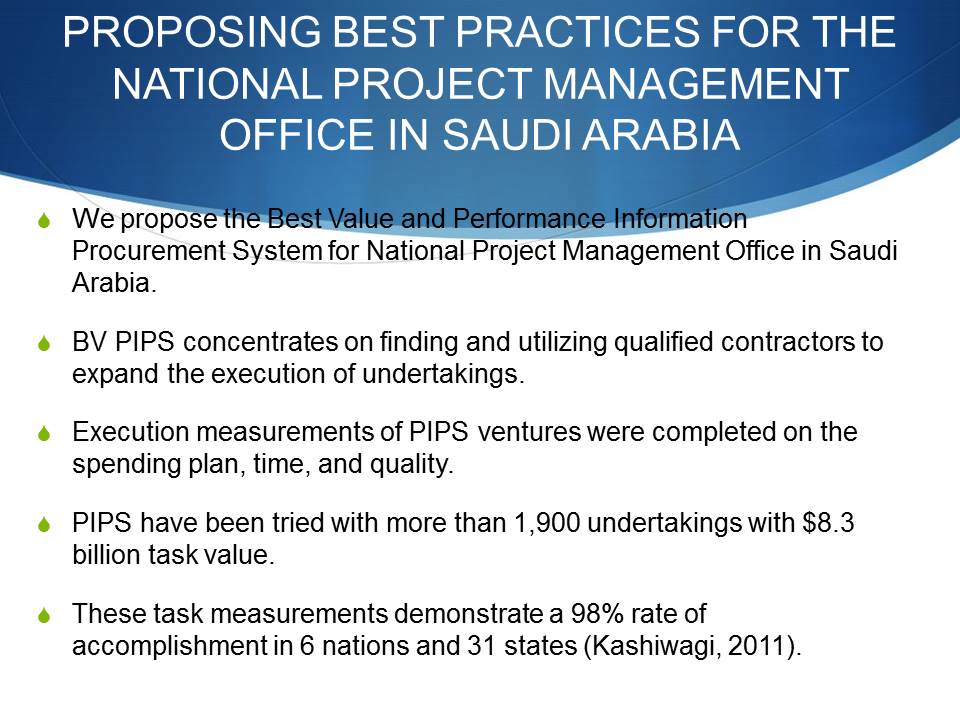
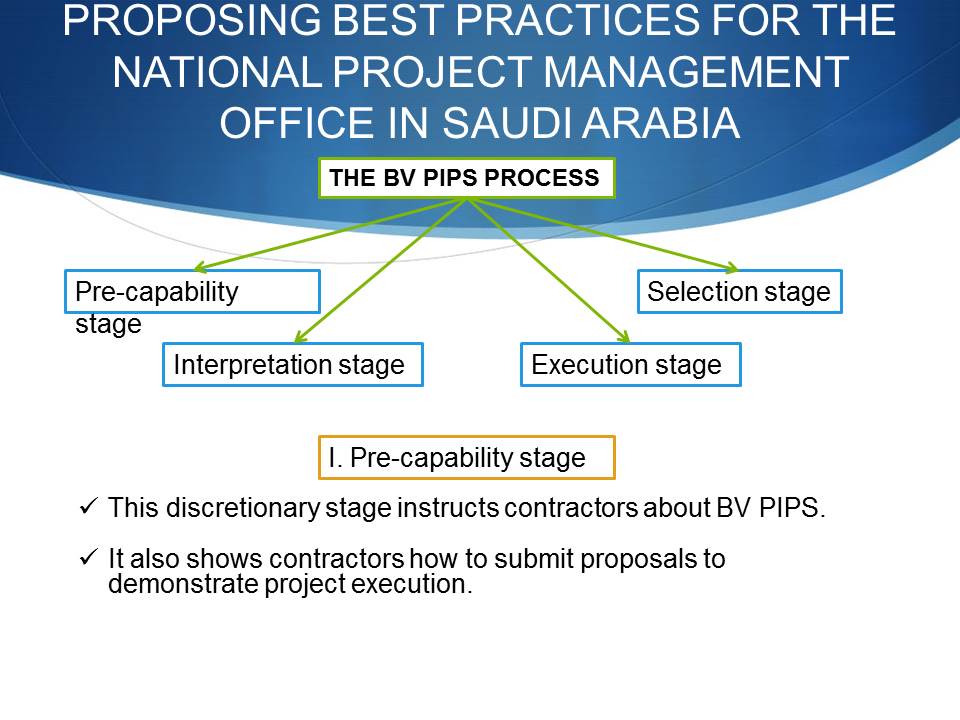
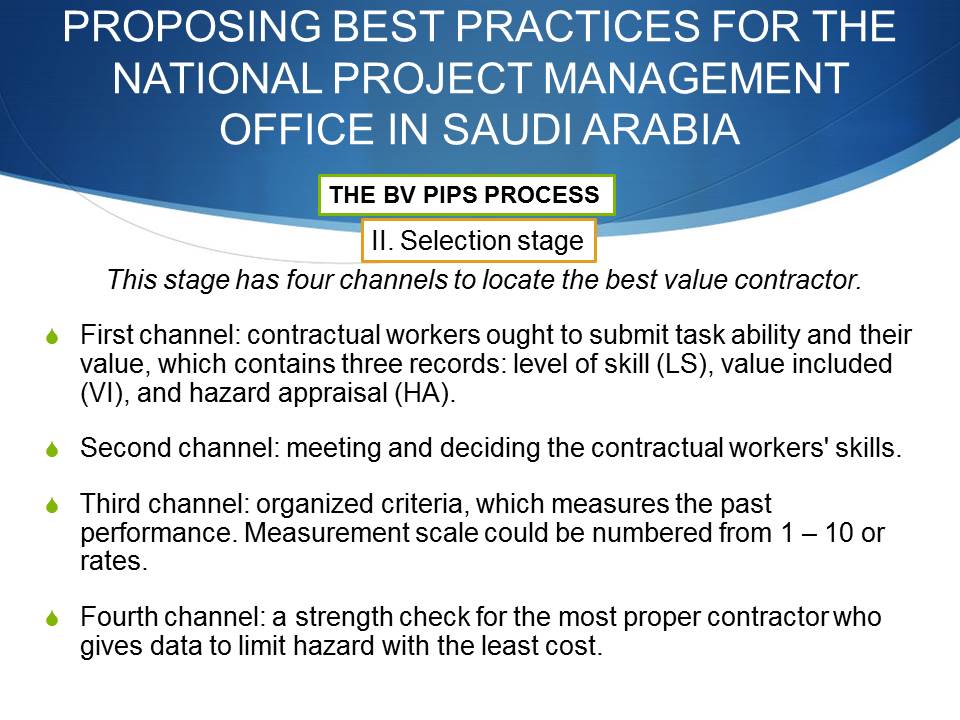
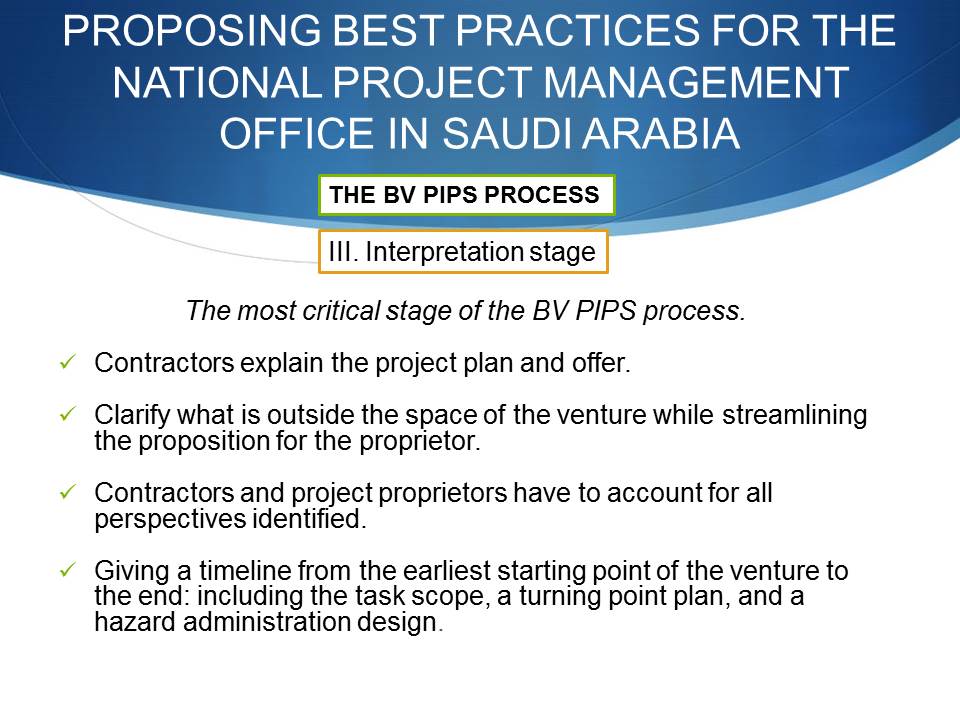
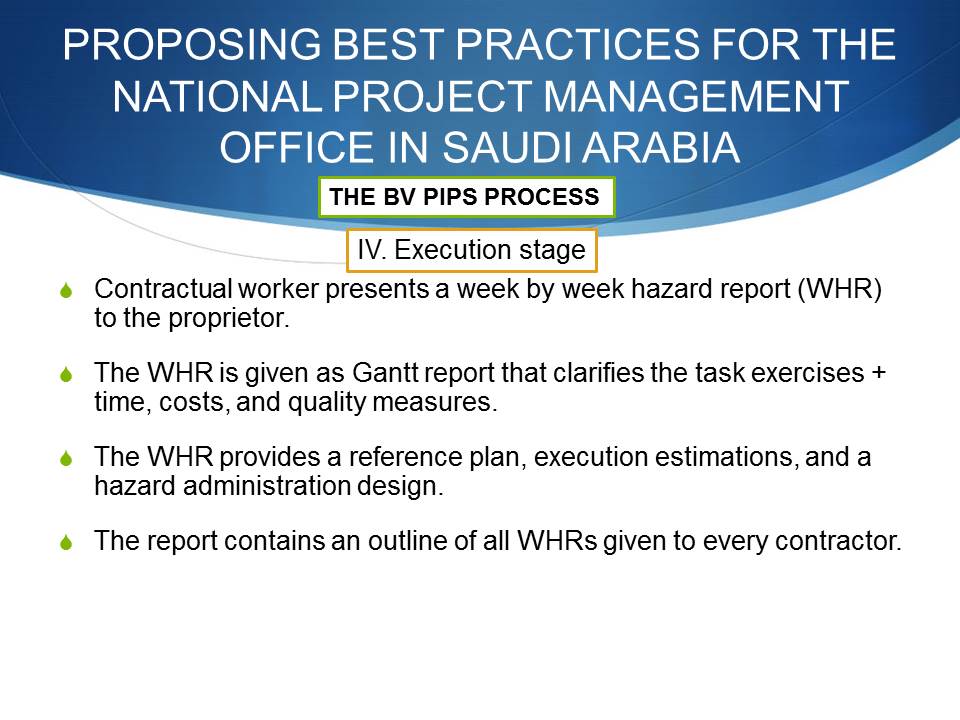
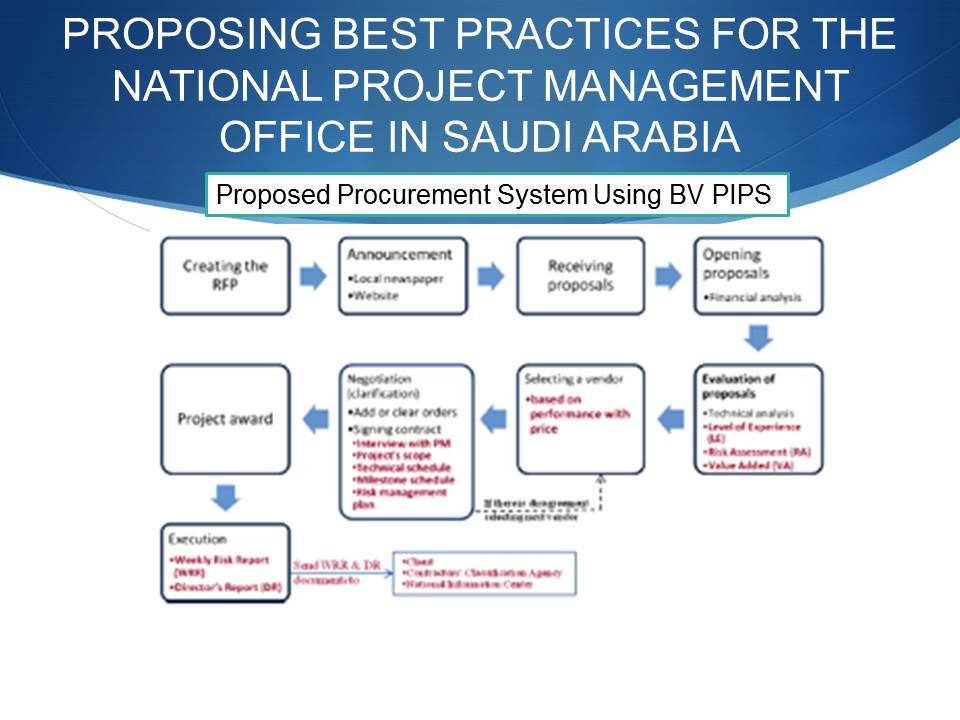
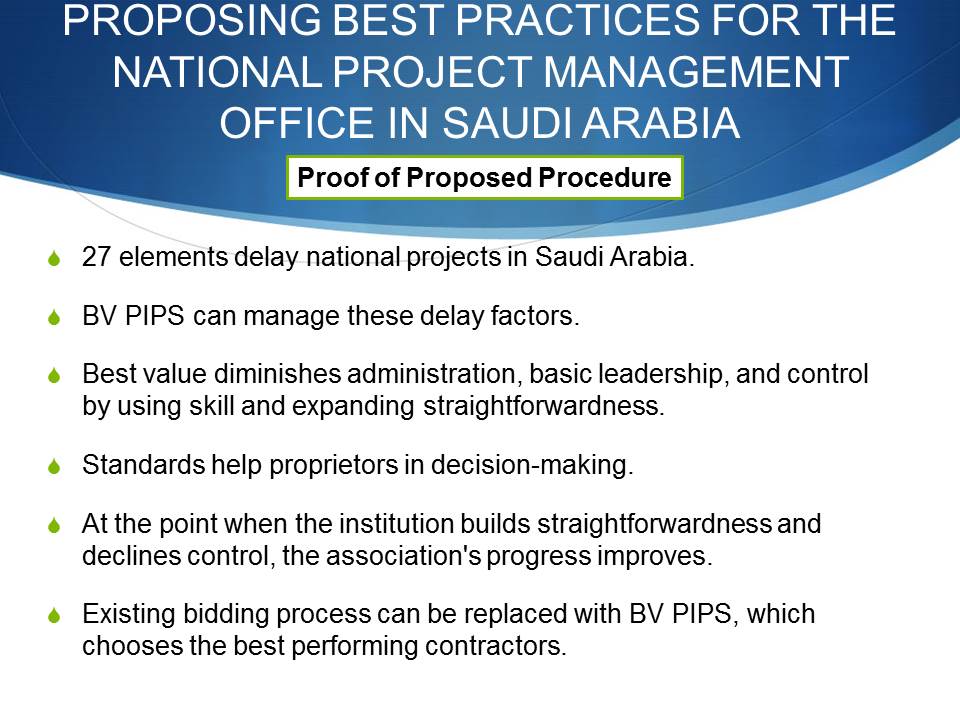
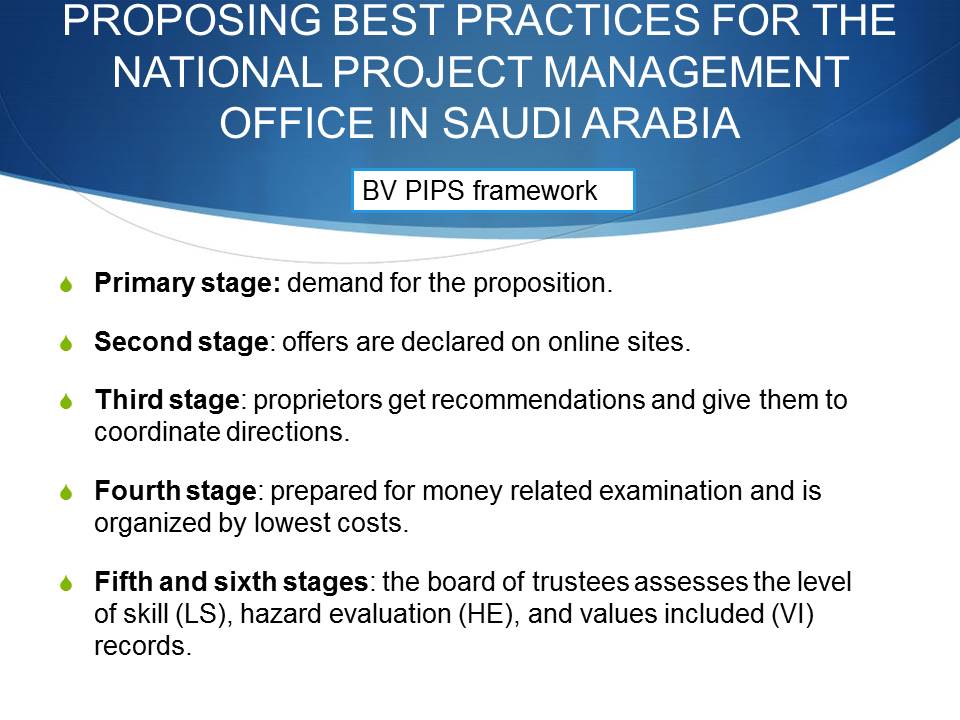
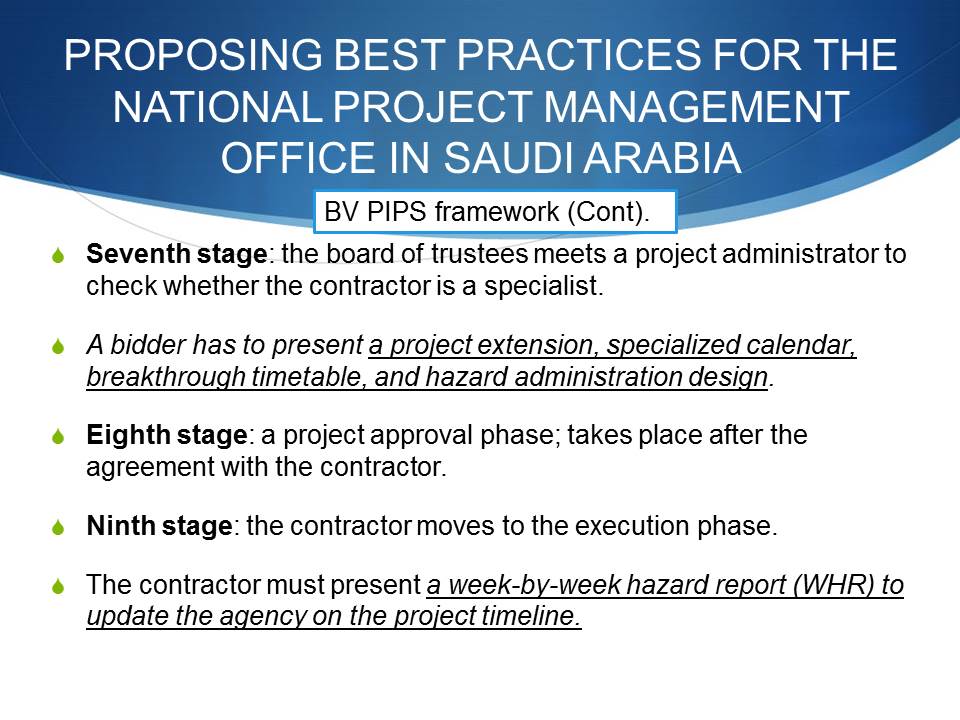
Conclusions
- The proposed model encourages automated project instruments and graphs.
- Appropriate planning is an unquestionable requirement in complex ventures.
- Improper planning can cause wrong cost estimations and project delays.
- The proposed model allows the government to track progress report.
- Contractors and government authorities must utilize the BV PIPS components for project approval.
- Level of understanding, hazard evaluation, and value-included records help proprietors to assess site engineers based on quality and performance.
To conclude, the BV PIPS framework will be effective in improving instruments within construction projects through the planning of complex ventures. BV PIPS is expected to enhance understanding levels, evaluation of hazards, and value-included records. Importantly, the proposed network can be useful for contractors and Saudi Arabian authorities for the approval and management of construction-related processes.
- The low-offer acquisition framework adversely influences the Saudi Arabian project execution.
- Fulfillment of the present (low-offer) framework is poor, as revealed in previous research.
- Gantt diagrams + other tools improve delivery timelines and mitigate cost overruns.
- The model ensures that stakeholders agree before project approval and implementation.
- Correspondence can help diminish deferrals by reducing project delay factors and improving the work plan.
- A contractor needs to track project report using different measurements.
As identified previously, the Saudi Arabian project execution suffers from deferrals. This can be improved with the use of Gantt diagrams and other tools that help stakeholders have better communication about their projects. Viable correspondence between key players will be effective for improving overall plans using the BV PIPS framework.
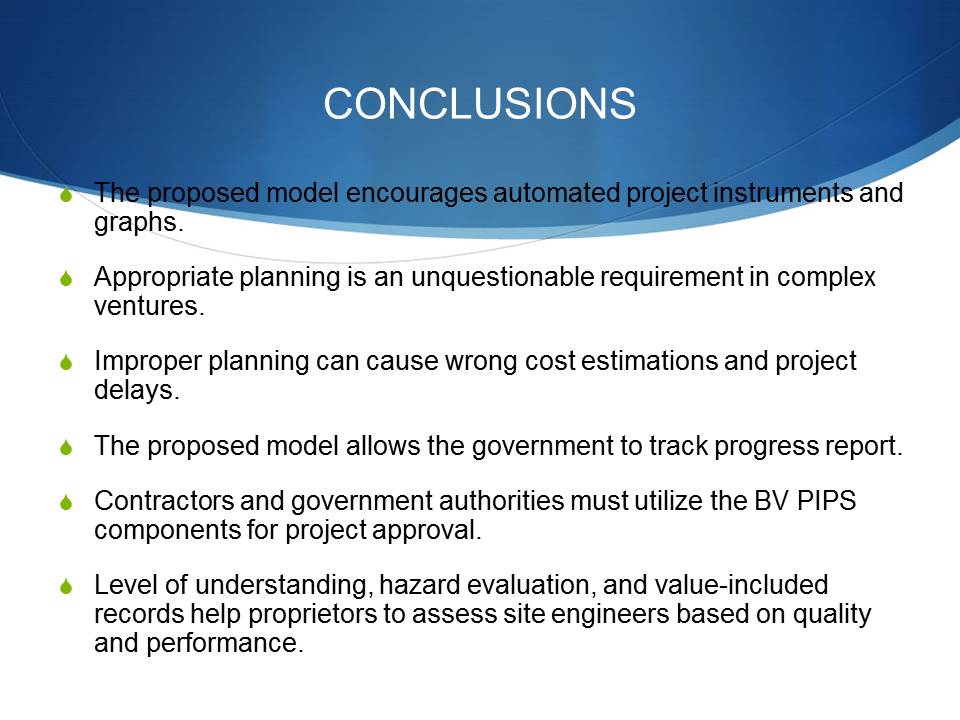
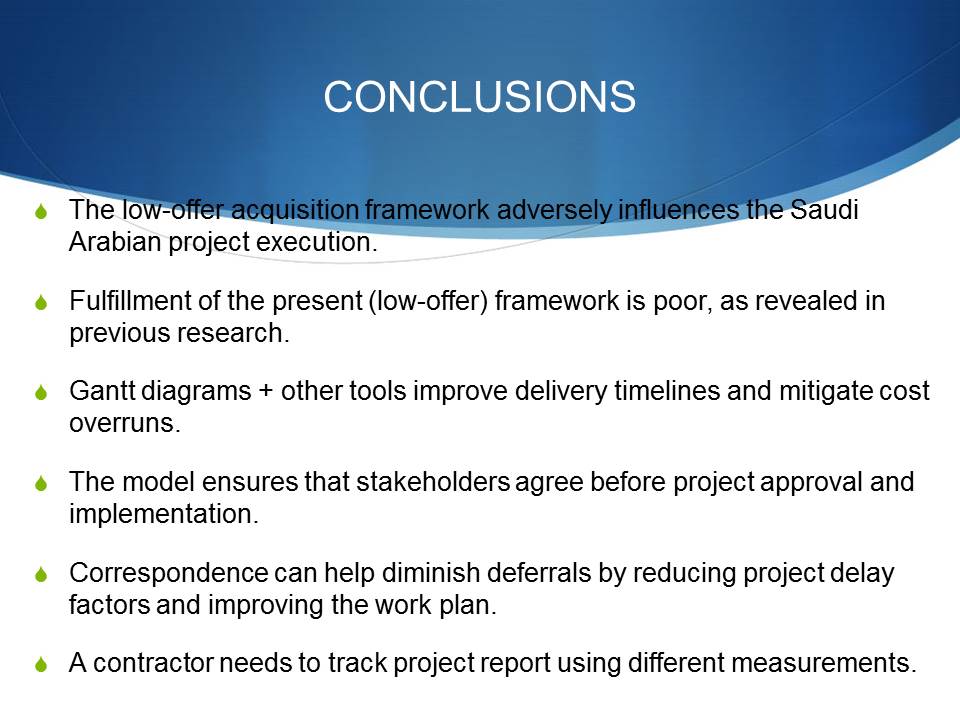
References
Abu Nemeh, M. H. A. (2012). Multi-criteria decision making model for the selection of a construction contractor in Saudi Arabia. Web.
Al Turkey, T. (2011). The reality of projects in terms of organization and structure, and the reasons for success and failure In Saudi Arabia. Web.
Al-Kharashi, A., & Skitmore, M. (2009). Causes of delays in Saudi Arabian public sector construction projects. Construction Management and Economics, 27(1), 3-23.
Al-Sultan, A. S. (1987). Determination of construction contract duration for public projects in Saudi Arabia. Web.
Alzara, M., Kashiwagi, J., Kashiwagi, D., & Al-Tassan, A. (2016). Important causes of delayed projects in Saudi Arabia vs. PIPS: A university campus case study. Journal for the Advancement of Performance Information & Value, 8(1), 3-8.
Assaf, S. A., & Al-Hejji, S. (2006). Causes of delay in large construction projects. International Journal of Project Management, 24(4), 349-357.
Elawi, G. S. A., Algahtany, M., & Kashiwagi, D. (2016). Owners’ perspective of factors contributing to project delay: Case studies of road and bridge projects in Saudi Arabia. Procedia Engineering, 145, 1402-1409.
Hirsch, A., & Catchim, T. (2012). The permanent revolution: Apostolic imagination and practice for the 21st century church. NY, New York: John Willey & Sons.
Holt, G. D., Olomolaiye, P. O., & Harris, F. C. (1995). A review of contractor selection practice in the UK construction industry. Building and Environment, 30(4), 553-561.
Kashiwagi, D. (2011). Case study: Best value procurement/performance information procurement system development. Journal for the Advancement of Performance Information & Value, 3(1), 1-5.
Mahamid, I. (2013). Contributions to schedule delay in public construction projects in Saudi Arabia: Owners’ perspective. Journal of Construction Project Management and Innovation, 3(2), 608-619.
Olaniran, O. J. (2015). The effects of cost-based contractor selection on construction project performance. Journal of Financial Management of Property and Construction, 20(3), 235-251.
Plebankiewicz, E. (2009). Contractor prequalification model using fuzzy sets. Journal of Civil Engineering and Management, 15(4), 377-385.
SelectedmegaconstructionprojectsinSaudiArabia [Image]. (2017). Web.
Wong, C. H., Holt, G. D., & Cooper, P. A. (2000). Lowest price or value? Investigation of UK construction clients’ tender selection process. Construction Management & Economics, 18(7), 767-774.